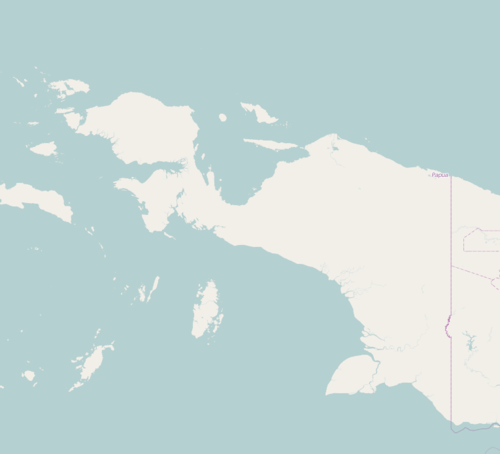Bomberai Peninsula
| Native name: Semenanjung Bomberai | |
|---|---|
 Bomberai Peninsula | |
| Geography | |
| Coordinates | 03°09′19.15″S 133°10′15.6″E / 3.1553194°S 133.171000°ECoordinates: 03°09′19.15″S 133°10′15.6″E / 3.1553194°S 133.171000°E |
| Adjacent bodies of water | Ceram Sea |
| Administration | |
|
Indonesea | |
Bomberai Peninsula (Indonesian: Semenanjung Bomberai) is located in the Western New Guinea region, in South East Asia, opposite to and to the south of the Bird's Head Peninsula. To the west lies the Sebakor Bay and to the south Kamrau Bay. Sabuda island lies off the western tip of the peninsula, and is separated from the mainland by Berau and Bintuni straits.
Geography
The entire peninsula is covered by a dense tropical rainforest, and most of the peninsula consists of a marshy plain. Together with the Bird's Head Peninsula and offshore islands, the Bomberai Peninsula forms the Indonesian province of West Papua (Indonesian: Papua Barat). The western part of the peninsula is occupied by Fakfak, the north belongs to Teluk Bintuni Regency and the southeast to Kaimana. It is a wide peninsula that opens to the sea of Ceram, forming a wide bay, the bay of Sebakor, defined by two small peninsulas:
- to the northwest, the peninsula of Onin or Fakfak, with the name of the city of Fakfak, the main town and port of the region. It is covered by a mountain range which reaches 1619 m altitude. Due to the facilities offered by the city Fakfak, this part of the Bomberai peninsula is the most visited.[1]
- to the southeast, the peninsula formed by the Kumafa mountains, whose south coast is bathed by the sea of Arafura. It is a region little explored and almost unknown.
To the north lie the Berau Bay and Bintuni Bay, which separate the Bomberai Peninsula from the Bird's Head peninsula. Off the north coast are located the islands Amutu Besar, Asap, Arguni and Ogar. Opposite is the island of Panjang in Tamaruni Bay.[2][3]
Further south are the island of Samai and Sebakor Bay, which is protected from the offshore island of Karas to the Tamaruni Bay. Southeast beyond the Nautilus Strait (Indonesian: Selat Nautilus) is the island of Adi.[4] In the east, Kamrau Bay separates the peninsula from the rest of New Guinea. At its northernmost point lies the island of Freterenusu in the bay. Only narrow land bridges connect the Bomberai peninsula with the neighboring land masses.
History
The first sighting by Europeans of this zone was in 1606, in the Spanish expedition commanded by Luís Vaz de Torres.
Population
Traditionally different languages are spoken on the peninsula. The Central Malayo-Polynesian languages have four languages in the north and one in the south with a total of 2600 speakers.
Mor (in the northwest) and three other languages of the peninsula are attributed to the Trans–New Guinea languages family of the Papuan languages. It is spoken by more than 7000 people. There are theories that the East Timorese Papuan language Fataluku and other Timor–Alor–Pantar languages originally came from the Bomberai Peninsula.[5]
Fauna
Twenty-four endemic species of rainbow fish (Melanotaenia) live on the Bird's Head Peninsula, Bomberai Peninsula and offshore islands. Many live in the karst areas, including the Harlequin Rainbow Fish (Melanotaenia boesemani).[6]
Fauna of the Fakfak Mountains includes the black-eared catbird and Oninia senglaubi, a member of the family of the narrow-mouthed frogs (Microhylidae).[7]
References
- ↑ Onin Peninsula (Fakfak), The Papua Insects Foundation.
- ↑ Der große Weltatlas, Millenium House, 2009, ISBN 978-1-921209-31-4.
- ↑ Stephen Backshall: The Rough Guide to Indonesia, S.1022, 2003, ISBN 978-1-858289-91-5.
- ↑ A directory for the navigation of the Indian Archipelago, China, and Japan, from the straits of Malacca and Sunda, and the passages east of Java. To Canton, Shanghai, the Yellow Sea, and Japan, with descriptions of the winds, monsoons, and currents, and general instructions for the various channels, harbours, etc. By Alexander George Findlay. Published: London, R. H. Laurie, 1878.
- ↑ Andrew McWilliam: Austronesians in linguistic disguise: Fataluku cultural fusion in East Timor
- ↑ Nugraha, M.F.I., Kadarusman, Hubert, N., Avarre, J.C., Hadiaty, R.K., Slembrouck, J., Carman, O., Sudarto, Ogistira, R. & Pouyaud L. (2015): Eight new species of Rainbowfishes (Melanotaeniidae) from the Birds Head Region, West Papua, Indonesia. Cybium, 39 (2): 99-130.
- ↑ Darrel R. Frost: Oninia senglaubi. Amphibian Species of the World, an Online Reference, Version 6.0. American Museum of Natural History, New York 1998–2015, abgerufen am 21. Dezember 2015